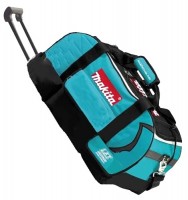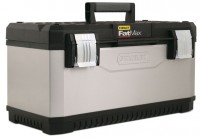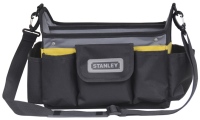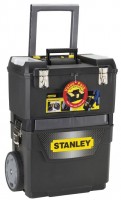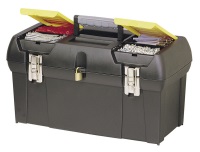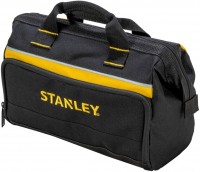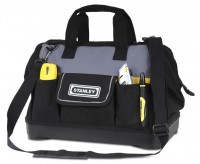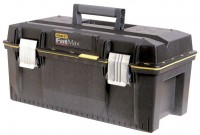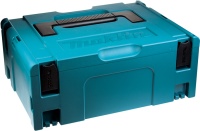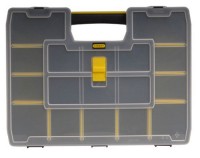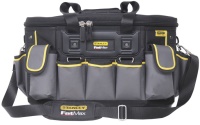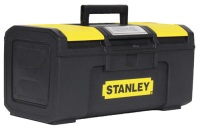Tool boxes Bosch
All Tool Boxes Advanced filters → |
You might be interested in
Articles, reviews, useful tips
All materials
Sparks, smoke, crunch and burning smell: what can break in a drill or screwdriver
We understand why drills and screwdrivers smoke, spew sparks, overheat, make strange sounds and work poorly

Screwdrivers and drills for dummies
Questions about drills and screwdrivers that beginners are embarrassed to ask more experienced craftsmen
Tool boxes: specifications, types
Type
A common type of container for tools. In addition to traditional boxes, nowadays there are such types as a case, organizer, bag, backpack, waist bag (holster) , vest (apron), soft case (organizer), tray, trolley and the original box-chair, which can be in the shape of a bag. Here are the main features of these options:
- Box. In this case, boxes mean containers made of hard material (metal or plastic, see below), usually rectangular in shape, in which the bottom and 4 walls form a solid structure, and the cover (removable or hinged) is located on top and secured with special locks. In some models, the role of the cover can be played by sliding sections(see below). The boxes are designed primarily for storing tools in one place and carrying them over short distances (within the workshop or between the storage location and the machine); Although most of these products are equipped with handles, they are not as convenient for long-term transportation in the hands as cases (see below). But among the advantages of the boxes, it is worth mentioning good capacity and fai...rly reliable protection of the instrument from contact with surrounding objects and adverse influences (dust and moisture). And some models even have the shape of a chair, both for resting the master and for use as a small stepladder.
- Case. Like the boxes described on top, cases are containers made of rigid materials, but the design of these containers is significantly different. Externally, the classic case resembles a suitcase, has a small height, when opened, it folds out lengthwise into two halves (some models can be conveniently opened regardless of which half the product is on top), and the carrying handle, which is a mandatory element of the case design, is not located on top, and on the side end. Thanks to this handle arrangement and flat shape, the cases are very convenient to carry in your hands; this is the option preferred by many craftsmen who often have to move from place to place. Among the disadvantages of such models, one can only note that they are unsuitable for large-sized tools - due to the aforementioned small thickness.
— Organizer. Organizers are containers for tools, the internal space of which is small in height and divided by partitions into separate cells (compartments). Most of these models are similar in design to the cases described on top (in particular, they open in a similar way and have a characteristic carrying handle), but there are other options - for example, a cabinet with several pull-out sections installed on top of each other. The cells are small in size, making the organizers excellent for storing small fasteners (bolts and nuts, screws, etc.), as well as tool accessories (such as sockets or bits). However, in most cases, the size of the compartments can be changed (see below for more details), which allows you to store larger items such as a screwdriver, pliers or even an adjustable wrench in such a container. Note that organizers can be useful not only to owners of hand tools, but also to anyone who has to deal with an abundance of small items - in particular, seamstresses and fishermen.
- Tray. Trays are open fixtures; some of them look like boxes without a cover, some look like flat trays with recesses for tools. In any case, such devices are not designed for long-term transportation of the tool in the hands - and some have no handles at all and are designed to be permanently in one place (for example, on a shelf in the workshop). The degree of protection provided by the trays is also low due to the open design; their main advantage is the ability to quickly access content.
- Bag. Externally, tool bags tend to look similar to regular sports bags - most have a distinctive pair of handles and a shoulder strap (see below). Such products combine the advantages of boxes and cases: on the one hand, they are quite roomy and suitable even for large-sized items, on the other hand, they are easy to carry and are much better suited than boxes for frequent travel on foot or by public transport. The main disadvantage of bags is that they are made of soft fabric, which is poorly suited for carrying heavy tools and does not provide the same degree of protection as metal or plastic. However, many models provide a built-in rigid frame that corrects the situation.
- Backpack. Modern backpacks for tools are similar in appearance to classic backpacks for “urban” purposes (similar to how the “tool” bags described on top are similar to ordinary ones), but inside they have special devices for placing tools, and are also often equipped with a frame of increased rigidity, necessary for carrying massive items. The advantage of this type over bags is that a backpack worn by both straps leaves your hands free, and in general, carrying it on your shoulders is less tiring than in your hands. On the other hand, it takes longer to get to the tool in your backpack.
— Belt bag (holster). This name includes various devices for carrying tools on a belt. This can be either a separate bag that attaches to any more or less suitable belt, or a belt with several of its own bags for tools. A “holster” is an open-type belt bag without a flap covering it on top. It can also be carried out separately or equipped with its own belt (often there are several holsters on one belt). The open design allows you to quickly remove and hide the tool, however, such bags are less reliable than closed ones - the contents may fall out if turned over. In general, regardless of type, fanny packs are great for situations where you need to constantly move, keep your hands free and at the same time always have certain tools nearby. One example of such an application is work at heights. Vests/aprons have similar specifics (see below); They are more spacious, but the belt is easier to choose in size.
— Vest (apron). A device in the form of a piece of clothing - most often a vest, but aprons are also found. In any case, such a piece of clothing has pockets, loops and other “seats” for various tools, and is also made of durable materials that can easily carry the significant weight of worn equipment. Vests and aprons are convenient primarily in situations where you need to constantly have a significant number of tools on hand, and other types of containers are inconvenient or impossible to use. An example is installation work at high altitudes (some vests are even called “installer’s vest”). The belt bags described on top have a similar purpose; At the same time, vests/aprons are more bulky and require more careful selection in size, but their capacity is much higher.
— Soft case (organizer). A device in the form of a piece of durable fabric (usually rectangular) with pockets and sockets for tools sewn onto it. For storage/carrying, such fabric can be folded “tools inward” and secured with a special fastener, and if necessary, the cover can be quickly unfolded. The similarity with organizers is that such products often have many small spaces for small items. In general, from a practical point of view, cases are somewhat inferior to boxes in terms of protection, but with similar capacity they are lighter and more compact.
- Cart. Carts are containers equipped with wheels and handles for easy transportation. It only makes sense to use transport on wheels for large sets of tools that would be too heavy and inconvenient to carry in your hands or on yourself. Therefore, the carts are large in size and have a large capacity, and their working volume is divided into separate sections - most often retractable - otherwise it would be impossible to properly accommodate the entire tool. The main place where such containers are used are large workshops, hangars and other similar facilities, where a large arsenal of tools must often be moved over short distances; Carts are not suitable for “serious” transportation (unless you secure such a device in the back of a truck).
- Box. In this case, boxes mean containers made of hard material (metal or plastic, see below), usually rectangular in shape, in which the bottom and 4 walls form a solid structure, and the cover (removable or hinged) is located on top and secured with special locks. In some models, the role of the cover can be played by sliding sections(see below). The boxes are designed primarily for storing tools in one place and carrying them over short distances (within the workshop or between the storage location and the machine); Although most of these products are equipped with handles, they are not as convenient for long-term transportation in the hands as cases (see below). But among the advantages of the boxes, it is worth mentioning good capacity and fai...rly reliable protection of the instrument from contact with surrounding objects and adverse influences (dust and moisture). And some models even have the shape of a chair, both for resting the master and for use as a small stepladder.
- Case. Like the boxes described on top, cases are containers made of rigid materials, but the design of these containers is significantly different. Externally, the classic case resembles a suitcase, has a small height, when opened, it folds out lengthwise into two halves (some models can be conveniently opened regardless of which half the product is on top), and the carrying handle, which is a mandatory element of the case design, is not located on top, and on the side end. Thanks to this handle arrangement and flat shape, the cases are very convenient to carry in your hands; this is the option preferred by many craftsmen who often have to move from place to place. Among the disadvantages of such models, one can only note that they are unsuitable for large-sized tools - due to the aforementioned small thickness.
— Organizer. Organizers are containers for tools, the internal space of which is small in height and divided by partitions into separate cells (compartments). Most of these models are similar in design to the cases described on top (in particular, they open in a similar way and have a characteristic carrying handle), but there are other options - for example, a cabinet with several pull-out sections installed on top of each other. The cells are small in size, making the organizers excellent for storing small fasteners (bolts and nuts, screws, etc.), as well as tool accessories (such as sockets or bits). However, in most cases, the size of the compartments can be changed (see below for more details), which allows you to store larger items such as a screwdriver, pliers or even an adjustable wrench in such a container. Note that organizers can be useful not only to owners of hand tools, but also to anyone who has to deal with an abundance of small items - in particular, seamstresses and fishermen.
- Tray. Trays are open fixtures; some of them look like boxes without a cover, some look like flat trays with recesses for tools. In any case, such devices are not designed for long-term transportation of the tool in the hands - and some have no handles at all and are designed to be permanently in one place (for example, on a shelf in the workshop). The degree of protection provided by the trays is also low due to the open design; their main advantage is the ability to quickly access content.
- Bag. Externally, tool bags tend to look similar to regular sports bags - most have a distinctive pair of handles and a shoulder strap (see below). Such products combine the advantages of boxes and cases: on the one hand, they are quite roomy and suitable even for large-sized items, on the other hand, they are easy to carry and are much better suited than boxes for frequent travel on foot or by public transport. The main disadvantage of bags is that they are made of soft fabric, which is poorly suited for carrying heavy tools and does not provide the same degree of protection as metal or plastic. However, many models provide a built-in rigid frame that corrects the situation.
- Backpack. Modern backpacks for tools are similar in appearance to classic backpacks for “urban” purposes (similar to how the “tool” bags described on top are similar to ordinary ones), but inside they have special devices for placing tools, and are also often equipped with a frame of increased rigidity, necessary for carrying massive items. The advantage of this type over bags is that a backpack worn by both straps leaves your hands free, and in general, carrying it on your shoulders is less tiring than in your hands. On the other hand, it takes longer to get to the tool in your backpack.
— Belt bag (holster). This name includes various devices for carrying tools on a belt. This can be either a separate bag that attaches to any more or less suitable belt, or a belt with several of its own bags for tools. A “holster” is an open-type belt bag without a flap covering it on top. It can also be carried out separately or equipped with its own belt (often there are several holsters on one belt). The open design allows you to quickly remove and hide the tool, however, such bags are less reliable than closed ones - the contents may fall out if turned over. In general, regardless of type, fanny packs are great for situations where you need to constantly move, keep your hands free and at the same time always have certain tools nearby. One example of such an application is work at heights. Vests/aprons have similar specifics (see below); They are more spacious, but the belt is easier to choose in size.
— Vest (apron). A device in the form of a piece of clothing - most often a vest, but aprons are also found. In any case, such a piece of clothing has pockets, loops and other “seats” for various tools, and is also made of durable materials that can easily carry the significant weight of worn equipment. Vests and aprons are convenient primarily in situations where you need to constantly have a significant number of tools on hand, and other types of containers are inconvenient or impossible to use. An example is installation work at high altitudes (some vests are even called “installer’s vest”). The belt bags described on top have a similar purpose; At the same time, vests/aprons are more bulky and require more careful selection in size, but their capacity is much higher.
— Soft case (organizer). A device in the form of a piece of durable fabric (usually rectangular) with pockets and sockets for tools sewn onto it. For storage/carrying, such fabric can be folded “tools inward” and secured with a special fastener, and if necessary, the cover can be quickly unfolded. The similarity with organizers is that such products often have many small spaces for small items. In general, from a practical point of view, cases are somewhat inferior to boxes in terms of protection, but with similar capacity they are lighter and more compact.
- Cart. Carts are containers equipped with wheels and handles for easy transportation. It only makes sense to use transport on wheels for large sets of tools that would be too heavy and inconvenient to carry in your hands or on yourself. Therefore, the carts are large in size and have a large capacity, and their working volume is divided into separate sections - most often retractable - otherwise it would be impossible to properly accommodate the entire tool. The main place where such containers are used are large workshops, hangars and other similar facilities, where a large arsenal of tools must often be moved over short distances; Carts are not suitable for “serious” transportation (unless you secure such a device in the back of a truck).
Kit
The number of individual boxes or bags included in the delivery. The larger the set, the more tools you can load into them and the more space you will need to place them. In most modern sets of boxes and bags, this number is 2 – 3, which is quite enough.
Suitable for
A kind of tool for which the container is normally intended.
— For hand tools. Products intended primarily for hand tools — hammers, screwdrivers, pliers, etc. Such a tool has a relatively small size and, most often, a standard shape; so for such boxes it makes no sense to indicate compatibility (see below). Note that such products are not suitable for small items — so if you plan to work with a large amount of “little things”, you should find a container that was originally designed for this (see below).
— For tools and small things. Containers designed both for hand tools (see above) and for storing numerous small parts. The specific design of such products may be different. So, in classic boxes (see "Type") for little things, a lid with an organizer is most often provided (see below); individual organizers for this purpose have compartments of different sizes; in vests and fanny packs, pockets differ in size, respectively, etc.
— Only for small items. Containers designed only for small parts — fasteners (bolts, nuts, screws, nails), some types of working attachments (drills, bits), etc. The vast majority of such containers are organizers (see "Type"), although there are and exceptions.
— For power tools. Containers for this purpose are highly specialized, they are usually made for specific models of...power tools (see "Compatibility"). This is due to the fact that similar tools (even those of similar purpose and level) differ markedly in their general structure and arrangement of various structural elements. And even if compatibility is not indicated for such a container, most likely it is intended at least for equipment from a certain brand.
— For hand tools. Products intended primarily for hand tools — hammers, screwdrivers, pliers, etc. Such a tool has a relatively small size and, most often, a standard shape; so for such boxes it makes no sense to indicate compatibility (see below). Note that such products are not suitable for small items — so if you plan to work with a large amount of “little things”, you should find a container that was originally designed for this (see below).
— For tools and small things. Containers designed both for hand tools (see above) and for storing numerous small parts. The specific design of such products may be different. So, in classic boxes (see "Type") for little things, a lid with an organizer is most often provided (see below); individual organizers for this purpose have compartments of different sizes; in vests and fanny packs, pockets differ in size, respectively, etc.
— Only for small items. Containers designed only for small parts — fasteners (bolts, nuts, screws, nails), some types of working attachments (drills, bits), etc. The vast majority of such containers are organizers (see "Type"), although there are and exceptions.
— For power tools. Containers for this purpose are highly specialized, they are usually made for specific models of...power tools (see "Compatibility"). This is due to the fact that similar tools (even those of similar purpose and level) differ markedly in their general structure and arrangement of various structural elements. And even if compatibility is not indicated for such a container, most likely it is intended at least for equipment from a certain brand.
Compatibility
Models of power tools with which the box for the corresponding purpose is compatible (see above). Usually, such boxes are produced by large tool manufacturers specifically for their products; therefore, in this paragraph, only the index of the model of the power tool is often indicated — it has the same manufacturer as the box.
Size
The main size of the container for tools. Inches are traditionally used for this designation, and the length is usually indicated as the main size. This information allows you to evaluate the "weight category" of the product as a whole, as well as to determine whether it is suitable for a particular instrument of large sizes. At the same time, the characteristics usually indicate the overall dimensions on all three main sides (in millimetres), however, it is more convenient for many craftsmen to use the size designation in inches.
For kits (see below), this paragraph indicates the dimensions of all containers supplied in the kit.
For kits (see below), this paragraph indicates the dimensions of all containers supplied in the kit.
Сompartments
The number of compartments and/or pockets provided in the design of the tool container (with the exception of organizers, including those built into the lid — for them the number of cells is indicated separately, see below).
The more compartments or pockets, the easier it is to keep numerous items in the container at the same time. On the other hand, more compartments (for the same product size) usually means smaller individual compartments. The most modest models have up to 10 compartments / pockets, in the most capacious this number can exceed 30. Of course, when choosing by this parameter, you should take into account the type of container (see above). So, for traditional boxes, the maximum value is actually 20 compartments, and among backpacks there are models with 20 – 30 compartments.
The more compartments or pockets, the easier it is to keep numerous items in the container at the same time. On the other hand, more compartments (for the same product size) usually means smaller individual compartments. The most modest models have up to 10 compartments / pockets, in the most capacious this number can exceed 30. Of course, when choosing by this parameter, you should take into account the type of container (see above). So, for traditional boxes, the maximum value is actually 20 compartments, and among backpacks there are models with 20 – 30 compartments.
Sections
Design of movable sections mounted in a tool box or other container. A section is a separate movable unit, usually divided into several compartments (see above). The meaning of such blocks is to ensure the compactness of the container when folded and the convenience of access to the contents when unfolded. The types of sections can be as follows:
— Sliding. Sections located at the top of the container and also playing the role of a cover for its lower part. Typically, such sections are made in pairs or quadruples, 2 pairs each, and when opened, in accordance with the name, they diverge in different directions, allowing you to get to the space below them. This variety is found mainly in boxes (see "Type").
— Retractable. Sections that slide out of the inner volume of the container are like drawers in a desk or kitchen table. This design is used in organizers and trolleys(see "Type").
— Sliding. Sections located at the top of the container and also playing the role of a cover for its lower part. Typically, such sections are made in pairs or quadruples, 2 pairs each, and when opened, in accordance with the name, they diverge in different directions, allowing you to get to the space below them. This variety is found mainly in boxes (see "Type").
— Retractable. Sections that slide out of the inner volume of the container are like drawers in a desk or kitchen table. This design is used in organizers and trolleys(see "Type").
Lid organizer
The presence of a built-in organizer in the lid of the container for tools.
The features of organizers are described in detail in the "Type" section; this variety differs only in that it is built into the lid, and is not made as a separate device. The combination of a drawer or case with an organizer allows you to conveniently store both large tools and small items such as fasteners or interchangeable nozzles in one container: the main volume is well suited for the former, while the latter are convenient to keep in small organizer cells.
The features of organizers are described in detail in the "Type" section; this variety differs only in that it is built into the lid, and is not made as a separate device. The combination of a drawer or case with an organizer allows you to conveniently store both large tools and small items such as fasteners or interchangeable nozzles in one container: the main volume is well suited for the former, while the latter are convenient to keep in small organizer cells.
Organizer slots
The number of individual cells provided in the organizer. In this case, we can talk about an organizer as a separate device (see "Type"), or a set of cells built into the lid of the box (see "Lid with an organizer"). And for solutions with removable partitions, in which cells can be combined, the maximum number is indicated — with all installed partitions.
Organizers, by definition, are designed mainly for small things. Therefore, the more cells there are, the more varieties of small items can be stored in a container. For example, in 10 cells you can keep bolts of five different sizes and separately nuts for them. Such a number of compartments — up to 10 — is generally considered small, but in fact it is often quite enough. 11 – 20 cells can be called an average, and the most capacious organizers have up to 30 compartments. However it is worth considering that with the same dimensions of the container, an increase in the number of cells leads to a decrease in their volume.
Organizers, by definition, are designed mainly for small things. Therefore, the more cells there are, the more varieties of small items can be stored in a container. For example, in 10 cells you can keep bolts of five different sizes and separately nuts for them. Such a number of compartments — up to 10 — is generally considered small, but in fact it is often quite enough. 11 – 20 cells can be called an average, and the most capacious organizers have up to 30 compartments. However it is worth considering that with the same dimensions of the container, an increase in the number of cells leads to a decrease in their volume.
Detachable organizer
The presence of a removable organizer, allows you to use it separately from the box. There are such cases mainly in models that have a lid with an organizer.
Place for bits and sockets
The presence on the lid of the box (may occur in other versions, but very rarely) of separate niches for bits and end heads. Something similar is implemented in tool kits, where each accessory has its place and clearly lies in it.
Adjustable compartment size
Possibility to change the size of the compartments provided in the tool box. This function is mainly used in organizers(see "Type"). Usually, the partitions in such products (all, or at least most) can be removed and rearranged, thus adjusting the size, number and even shape of the compartments — for example, to provide enough space for a relatively large tool like a screwdriver or pliers. Another option is bags and backpacks(see ibid.), in which individual compartments can grow and shrink through the use of zippers or zip ties. Here the meaning of this function is somewhat different: it is aimed at optimizing the use of internal space depending on the amount of content. For example, if there is little content, a bag or backpack can be “squeezed” so that things do not hang around the cabin; and when an additional load appears, loosen the ties or unzip, providing the necessary volume.
Detachable tray
The presence of a removable tray in the design of the container for tools (usually a box — see "Type").
The tray is an open platform — usually with recesses for easy placement of tools. On such a platform, you can lay out the items necessary for work, so that each time you do not climb deep into the box behind them; this is especially useful when tools need to be changed frequently during operation. And after hours, the tray is loaded into the box along with the tools, usually to the very bottom; in some models, the design of this “second bottom” is such that it can be quickly removed along with the entire contents of the box.
The tray is an open platform — usually with recesses for easy placement of tools. On such a platform, you can lay out the items necessary for work, so that each time you do not climb deep into the box behind them; this is especially useful when tools need to be changed frequently during operation. And after hours, the tray is loaded into the box along with the tools, usually to the very bottom; in some models, the design of this “second bottom” is such that it can be quickly removed along with the entire contents of the box.
Recessed handle
The presence of a recessed carrying handle in the design of the container.
Such a handle, as the name implies, when folded, is recessed into a special nest on the body, so that it does not protrude beyond the dimensions of the container and does not create unnecessary problems during storage and transportation. Note that in cases (see "Type") the handle is a harmonious continuation of the case, and this function is not used there (in fact, in such models, the handles themselves are clumsy). But in boxes where the handle is installed on the lid, a recessed design can be useful not only to reduce the size, but also so that another item can be placed on top of the box — for example, another box from the same set.
Such a handle, as the name implies, when folded, is recessed into a special nest on the body, so that it does not protrude beyond the dimensions of the container and does not create unnecessary problems during storage and transportation. Note that in cases (see "Type") the handle is a harmonious continuation of the case, and this function is not used there (in fact, in such models, the handles themselves are clumsy). But in boxes where the handle is installed on the lid, a recessed design can be useful not only to reduce the size, but also so that another item can be placed on top of the box — for example, another box from the same set.
Shoulder strap
The presence of a shoulder strap in the design of the container.
This feature is found mainly in bags (see "Type"), however, it can also be used in other varieties — for example, cases or fanny packs (in the latter case, the waist belt plays the role of a shoulder strap, stretchable to the desired size). Anyway, the shoulder strap provides additional convenience: transport on the shoulder is less tiring than in the hands, and the hands themselves remain practically free.
This feature is found mainly in bags (see "Type"), however, it can also be used in other varieties — for example, cases or fanny packs (in the latter case, the waist belt plays the role of a shoulder strap, stretchable to the desired size). Anyway, the shoulder strap provides additional convenience: transport on the shoulder is less tiring than in the hands, and the hands themselves remain practically free.
Transportation wheels
The presence of wheels for transportation in the design of the container.
This feature is, by definition, provided in trolleys (see "Type"), however, other types of containers can be equipped with wheels — boxes, cases and even backpacks and bags. Anyway, the presence of wheels means that we have a capacious product designed for an extensive set of tools — it would be difficult to carry such an “arsenal” by weight. Also note that the design of the wheels may vary — again, depending on the type. So, boxes and bags are equipped with a handle and a pair of wheels of a "suitcase" design — you need to roll such a product in an inclined position. Many trolleys have a similar device, but among them there are also models with four full-fledged wheels.
This feature is, by definition, provided in trolleys (see "Type"), however, other types of containers can be equipped with wheels — boxes, cases and even backpacks and bags. Anyway, the presence of wheels means that we have a capacious product designed for an extensive set of tools — it would be difficult to carry such an “arsenal” by weight. Also note that the design of the wheels may vary — again, depending on the type. So, boxes and bags are equipped with a handle and a pair of wheels of a "suitcase" design — you need to roll such a product in an inclined position. Many trolleys have a similar device, but among them there are also models with four full-fledged wheels.
Modular system
A feature found mainly in drawers, organizers and trolleys (see "Type"). The meaning of the modular system is that it allows you to put several containers one on top of the other, connecting them with special latches, and thus turn them into one common storage. At the same time, compatibility can be different, containers of the same brand and different types are often compatible - for example, additional boxes or organizers can be installed on some carts.
Material
The main material from which the tool box is made. Nowadays, products made of plastic and fabric are most widely used, metal options are less common, extremely rare — from wood and leather. Here are the features of each of these options:
— Plastic. Plastic is lightweight, easy to process, inexpensive and well suited for creating complex shapes. This makes it easy to manufacture containers that require a rigid body — mainly boxes, cases and organizers (see "Type"). In the latter case, plastic is also convenient because it can be transparent — this allows organizers to be equipped with lids through which you can see the contents of the cells. The strength of plastic, however, is somewhat lower than that of metal, but in this case this moment is not decisive — especially since very thick and durable plastic is usually used in tool containers (while the weight remains within reasonable limits due to the mentioned lightness of the material) . It is also worth mentioning the low thermal conductivity of this material (which makes it easier to carry the container at low temperatures — it does not cool hands as much as metal) and the absolute resistance to corrosion. All this has led to the significant popularity of plastic containers for tools.
— Metal. Another material used in solid tool containers. The main advantage of metal an...d its advantage over plastic can be called high strength; in addition, metal products look quite solid and give the impression of solidity and reliability. On the other hand, they weigh more than plastic ones, are more expensive, and as they are used, the metal can corrode (especially in conditions of high humidity). To protect against corrosion, the surface is often coated with paint or other special compound, but in the conditions in which tool boxes are usually used, such a coating is damaged quite easily. Therefore, metal containers are much less common than plastic ones.
— Textile. Soft material used in products of the corresponding type, in particular bags, vests and cases (see "Type"). However this softness is rather arbitrary — the fabric is thick and rather stiff. This material is presented on the market in many varieties that differ in characteristics, but its properties can be assessed by the price category of the product: the higher the price, the more high-quality and durable fabric, usually, the manufacturer uses.
— Wood. For a long time, wood was a very popular material for tool boxes, but with the advent of inexpensive and high-quality plastics, this option has practically disappeared from the scene. This is due to the fact that wood is somewhat more expensive than plastic, while it is less practical, more difficult to process, requires the use of special coatings to protect against moisture and other negative influences, and can crack from a strong impact (whereas a plastic case has a chance get rid of a dent or even a scratch). As a result, today this material is used mainly for aesthetic reasons — in expensive "designer" products of the premium class, created based not only on ease of use, but also on the traditional appearance.
— Skin. A rather specific material used mainly in bags — including waist bags (see "Type"). At the same time, both natural leather and one or another type of substitute can be used in the design; these details should be clarified separately, but here we note that in the case of leatherette, the more expensive the product, the better the material, usually. In addition, only part of the product can be made of leather — for example, a waist belt, complemented by fabric bags. Anyway, the skin as a whole is quite strong and reliable, but natural varieties are not cheap, and substitutes, again, can be of different quality. Therefore, nowadays, this option is rare — manufacturers often prefer relatively inexpensive and at the same time practical fabrics.
— Plastic. Plastic is lightweight, easy to process, inexpensive and well suited for creating complex shapes. This makes it easy to manufacture containers that require a rigid body — mainly boxes, cases and organizers (see "Type"). In the latter case, plastic is also convenient because it can be transparent — this allows organizers to be equipped with lids through which you can see the contents of the cells. The strength of plastic, however, is somewhat lower than that of metal, but in this case this moment is not decisive — especially since very thick and durable plastic is usually used in tool containers (while the weight remains within reasonable limits due to the mentioned lightness of the material) . It is also worth mentioning the low thermal conductivity of this material (which makes it easier to carry the container at low temperatures — it does not cool hands as much as metal) and the absolute resistance to corrosion. All this has led to the significant popularity of plastic containers for tools.
— Metal. Another material used in solid tool containers. The main advantage of metal an...d its advantage over plastic can be called high strength; in addition, metal products look quite solid and give the impression of solidity and reliability. On the other hand, they weigh more than plastic ones, are more expensive, and as they are used, the metal can corrode (especially in conditions of high humidity). To protect against corrosion, the surface is often coated with paint or other special compound, but in the conditions in which tool boxes are usually used, such a coating is damaged quite easily. Therefore, metal containers are much less common than plastic ones.
— Textile. Soft material used in products of the corresponding type, in particular bags, vests and cases (see "Type"). However this softness is rather arbitrary — the fabric is thick and rather stiff. This material is presented on the market in many varieties that differ in characteristics, but its properties can be assessed by the price category of the product: the higher the price, the more high-quality and durable fabric, usually, the manufacturer uses.
— Wood. For a long time, wood was a very popular material for tool boxes, but with the advent of inexpensive and high-quality plastics, this option has practically disappeared from the scene. This is due to the fact that wood is somewhat more expensive than plastic, while it is less practical, more difficult to process, requires the use of special coatings to protect against moisture and other negative influences, and can crack from a strong impact (whereas a plastic case has a chance get rid of a dent or even a scratch). As a result, today this material is used mainly for aesthetic reasons — in expensive "designer" products of the premium class, created based not only on ease of use, but also on the traditional appearance.
— Skin. A rather specific material used mainly in bags — including waist bags (see "Type"). At the same time, both natural leather and one or another type of substitute can be used in the design; these details should be clarified separately, but here we note that in the case of leatherette, the more expensive the product, the better the material, usually. In addition, only part of the product can be made of leather — for example, a waist belt, complemented by fabric bags. Anyway, the skin as a whole is quite strong and reliable, but natural varieties are not cheap, and substitutes, again, can be of different quality. Therefore, nowadays, this option is rare — manufacturers often prefer relatively inexpensive and at the same time practical fabrics.
Lock material
The material from which the container locks are made. Most often we are talking about fasteners that close a case or drawer, but sometimes this information is indicated for fasteners in bags, backpacks, etc. The main materials for their manufacture are:
- Plastic. Plastic is inexpensive, but in general it is inferior to metal in terms of strength and reliability. However, often these moments do not play a decisive role (or are compensated by design features - for example, the large thickness of individual parts).
- Metal. Metal locks are very durable and reliable, but they are more expensive than plastic ones. Tool boxes and containers made of almost any material can be equipped with such locks.
— Plastic with metal. This combination is not uncommon in the design of tool boxes and containers. As a rule, the locking bracket of the lock is made of metal, which bears the main load in the locking mechanism, and the “tongue” is made of plastic.
- Plastic. Plastic is inexpensive, but in general it is inferior to metal in terms of strength and reliability. However, often these moments do not play a decisive role (or are compensated by design features - for example, the large thickness of individual parts).
- Metal. Metal locks are very durable and reliable, but they are more expensive than plastic ones. Tool boxes and containers made of almost any material can be equipped with such locks.
— Plastic with metal. This combination is not uncommon in the design of tool boxes and containers. As a rule, the locking bracket of the lock is made of metal, which bears the main load in the locking mechanism, and the “tongue” is made of plastic.
Water resistant
The presence of a box for water protection of the tool. The level of protection is usually denoted by two digits according to the IP standard. The first digit indicates the protection against dust (maximum 6), the second indicates the degree of protection against water (maximum 8). The maximum degree of protection according to this standard is IP68, that is, complete tightness. There are also markings of the IPX4 type, where the first digit is not spelled out - this means that the box has not been officially certified for dust resistance. Also note that in models with water protection, the place where the cover fits is usually sealed with a rubber gasket.

